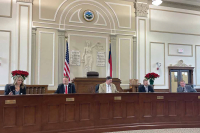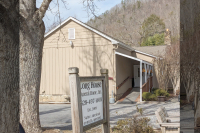Project will restore courthouse’s grandeur
While the feeling of stately grandeur evoked by Jackson’s historic courthouse has remained over the years, many of the original features of the building have not. Little by little, the courthouse architects, McMillan Smith and Partners out of South Carolina, hope to peel away layers of renovations and return some of the historical detail to the structure.
The three-story old courthouse was built in 1912 in a neoclassical, neotraditional style of architecture, says lead project architect Donny Love. A concrete foundation, unusual for the time, was poured, and wooden beams, including hemlock, were trucked up the steep hill to form the structure. It probably wasn’t an easy process, Love says.
“It would have been difficult, especially for the time, to build in that location,” he says. “With the types of equipment they had, it would have been seemingly difficult to transport the materials to the top of the hill and place them.”
The original building was actually red, not the stark white it is today. Most of its features were very much in keeping with the trends of the early century, including two story columns and a second story porch. Intricately carved banisters ran along each stairwell, and detailed wood trim covered the walls. Arches provided architectural detail common to the period.
But around the 1960s, the building underwent some heavy modifications. The wooden detail was removed, and staircases and the balcony overlooking the courtroom were replaced. The floor was covered over. Such updates were common in that era, Love says, and were meant to provide buildings with a more modern look — but they also erased some of the original detail.
“If they make it through that time period, often they’re not renovated and the original detail is still intact,” Love says.
The Jackson County courthouse hadn’t escaped that fate. The county hired Love’s firm to restore the building and design the library wing that will connect to it. But there was a challenge — there weren’t any original plans to draw from.
“There weren’t blueprints. Back then, they didn’t do a lot of drawings,” Love says.
Love’s firm had to go back and measure each room. As for determining what the original courthouse actually looked like, Love and his colleagues lucked out.
“The courthouse in Madison County was built by the same architect from essentially the same set of drawings,” says Love. “We visited that one to get an idea of what this building looked like before it was modified in the 1960s.”
The Madison County Courthouse had not undergone the same renovation cycle that Jackson County’s had, so it’s served as a roadmap for the architects in recreating the historical detail of Jackson’s.
Not every detail will be restored in the current renovation process, estimated at around $1 million for the courthouse alone. The large clock that hangs on the front of the courthouse, for instance, will stay, though it wasn’t part of the original structure. Initially, the area where the clock was likely had a skylight for the courtroom, Love says. The area was closed up, and the clock was placed on the building.
Other parts of the courthouse will look noticeably different than they do today. Plans call for replacing all the stairs leading up to the building, and placing streetlights along them as was the case originally.
With the groundbreaking of the new library last Saturday, work is already under way at the courthouse. One of the biggest challenges encountered so far is the stabilization of the site, which sits atop a steep hill. Plans call for the library building to come up to the edge of the hill, so a large retaining wall has had to be built.
“We’ve had to make the slope work with the building,” Love says.
Despite the challenges, Love says working on an old building, even one that doesn’t exactly resemble its historical self, is endlessly fascinating.
“It’s always neat to go in a building and try to understand what took place in it,” he says. “I think in this building, there wasn’t very much of the historic building left, but nevertheless you can still get kind of a neat feel for what it must have been like to sit in those offices and look over the whole town.”
New library complex will honor courthouse heritage
In Massachusetts, a vacant textile mill is now an art museum. An old city hall became a restaurant. In California, a sprawl of empty factories were transformed into a shopping district. Across the country, vacant industrial sites as well as landmark buildings are taking on different roles and a brand new life in projects that architects describe as “adaptive reuse.”
In 2010 Jackson County will complete its own example of modern Main Street redevelopment with the reopening of the restored historic courthouse and its new addition as the Jackson County Public Library Complex. Construction is scheduled to begin in May on the twin projects, which reflect more than a decade of discussion and planning by the community.
“In architectural designs nowadays, the emphasis is on being green and on recycling what we have,” said Donnie Love, historic preservation specialist at South Carolina-based McMillan Smith and Partners, architect for the project. “There’s just nothing more green than the reuse of an existing building like the Jackson County Courthouse, which was so important in the history of the county.”
The renovation of the 95-year-old structure and its expansion to provide modern, multimillion-dollar library facilities has won widespread community support. The project has raised local awareness about historic preservation and the benefits of bringing a new life and role to a landmark structure while retaining much of its original look and feel.
“The courthouse played such a large role in the past and now it will have an important role for a long time in the future. This is a terrific accomplishment for the people of Jackson County,” said Sylva native Ronnie Smith, one of the founders of McMillan Smith and Partners.
When the restoration is complete in 2010, the courthouse will house Jackson County’s Historical Association, Genealogical Society and Arts Council, and an auditorium. The 20,000-square-foot library to be built onto the back of the courthouse will have many of the same architectural details as the older building. A two-story atrium will connect the two buildings.
“This location is an ideal spot for the library,” said Smith. “People are going to be drawn to that location, and the buildings will see a lot of use.”
The project is expected to cost around $7.5 million, being paid for by the county. A campaign by the Friends of the Jackson County Main Library to raise an additional $1.6 million to be used for furnishings, fixtures and equipment has already raised nearly half of its goal.
“In some modern development, there has been a shift away from the adaptive reuse of historic buildings like this because of the fear that it would be too expensive to renovate them,” said Love. “The Jackson County project is a good example of how that’s not always true. The courthouse did fine in studies of what it would need to be brought back to a functioning facility, and because of the proximity to downtown, it was a great location for a new library.”
The Neoclassicism architecture of the courthouse was from the design of Richard Sharp Smith, one of the architects for the Biltmore House. Smith came to the mountain region in 1890 at the request of George Vanderbilt. He was a resident architect employed to help with the design and construction of the grand estate in Asheville.
Dreams for Swain’s old courthouse hinge on big money
Swain County would need more than $4 million to renovate its historic courthouse, putting plans for a cultural museum to be housed on the second floor in jeopardy.
The 1908 building has undergone few repairs since it was built, and thus accumulated a laundry list of expensive renovations.
“We’re looking for money — lots of money,” County Manager Kevin King told commissioners at the county’s annual retreat last Saturday (Jan. 31).
A structural engineering report commissioned by the county revealed the extent of repairs needed before a proposed cultural museum and visitors center can occupy the building.
The idea for a Swain County history museum and heritage center has been tossed around for years. Significant time has been invested in the idea, including picking stories to highlight, collecting oral histories, and most recently, applying for grants to fund the project.
But without massive structural repairs, the second floor could not safely house the museum or anything else.
“The second floor will hold itself up, but won’t hold much more weight,” explained King.
Repairing the second floor alone will cost $2 million, King said.
And any second floor renovations could delay the opening of a visitors center run by the Great Smoky Mountains Association proposed to occupy the first floor.
“We have to come in and do some massive renovations, and whatever renovations we do will impede the downstairs totally. For one, you’d have to drop the ceiling,” said King.
Of course, the second floor won’t necessarily have to be redone if plans for a museum are scrapped. That’s a decision commissioners will have to make — “if we want to continue with the museum on the second floor, or just the visitors center on the first floor,” King said.
Old Swain courthouse holds promise as museum, visitor center
A visitor center that would showcase the Great Smoky Mountains National Park and a local heritage museum could one day occupy the Swain County historic courthouse on Everett Street if and when the senior center currently in the courthouse moves out.
The visitors center will be run by the Great Smoky Mountains Association, a nonprofit that also runs a visitors center near the Smokemont Park entrance in Tennessee. The group has already pledged $100,000 to construct the center, according to Dan Wood, executive director of Swain County Partnership for the Future.
“They’ve been wanting a presence over on this part of the Park for a long time, and it’s a good fit right there with the Chamber of Commerce nearby,” said Wood.
Wood said the visitors center will feature five or six plasma screen televisions, one with a touch screen electronic map. The center will also house a small sandwich shop with drinks and coffee.
“We think a welcome center ... will bring more and more tourists to this area to stop by and map out their trip,” said Wood.
Wood and others had hoped to begin construction of the visitors center as early as March, but it’s now on hold indefinitely until the senior center can be relocated. Plans called for moving the senior center into a new building, but the county ran out of money to finish it.
The new senior center is being built with grant money, but the county only got half the grants it needed. Construction was launched with hopes more grant money would come through to complete it, but so far that hasn’t happened and the half-completed structure is in a holding pattern.
“Everything has ground to a halt with the senior center,” Wood said.
Wood is also reviving the idea for a Swain County history museum and heritage center to occupy the historic courthouse.
The idea has been tossed around for years. Initial plans called for the museum to focus on Swain County stories of national significance, including the creation of the Great Smoky Mountains National Park, the creation of Fontana Lake, the Eastern Band of Cherokee Indians and the region’s natural history.
A three-year planning process identified stories to be highlighted and work collecting oral histories was completed. A cost estimate was done, putting the total project cost at $1.5 million.
“Then, it kind of fell into a black hole of nothingness,” Wood said of the project. “Until I got here about a year ago, nothing had been done since 2004.”
Wood said arranging a move for the senior center has held up the process of planning for a visitors center and museum, which has been admittedly slow.
“Things move like a glacier,” he said. “But now, we’ve started to get money. I’ve written two separate grants (for the visitors center), and they both look good.”
Wood said the museum is likely at least two years from completion.
End in sight for cost overruns on Haywood courthouse
As renovation of Haywood County’s historic courthouse drags on, the county continues to tack on tens of thousands of dollars in additional costs over and beyond the project budget.
Last month, county commissioners approved an additional $45,000 in rent and phone lines for the temporary building housing county offices. That brings the total cost overruns to $262,923.
Included in that figure are $78,365 in consulting costs and $143,558 in attorney fees, both stemming from the county’s firing of the project’s original contracting firm and subsequent litigation.
The renovation of the courthouse is now 65 percent complete, and county officials think they’ll be able to stay within budget until the project is completed in April, said County Manager David Cotton.
The project was supposed to have been finished in June 2008, but stalled when the county fired KMD Construction, the contracting firm overseeing the renovations, on May 5. At the time, the project was behind schedule and the county wasn’t happy with the work KMD had done.
Work on the courthouse didn’t resume for several months until August while the county hashed out the details of finding a new contractor.
The search for a new firm fell on the shoulders of the bonding company the county used to insure the project. Though the bonding company hired another firm — Nicholson Professional Consulting — to provide direct supervision for the project, the labor is still being provided through KMD Construction. County commissioners approved the rehiring of KMD in a 4-1 vote.
Meanwhile, the county has been embroiled in a series of litigations against KMD, accusing the company of shoddy work and an inability to follow a timeline that caused the project to fall months behind schedule.
When finished, the courthouse will house various county services, including Veteran’s Affairs, Register of Deeds, Land Records, Geographical Information Systems, Tax Administration, Human Resources, Information Technology, Finance, and County Administration, according to Cotton.
Courthouse on track for bicentennial festivities
By Julia Merchant • Staff Writer
The renovation of Haywood County’s historic courthouse is halfway complete, and things continue to move along smoothly — for the most part.
Courthouse site doable for new Jackson library
Years of wrestling over a location for a new Jackson County library will come to a close next month.
Jackson County commissioners pledged to pick a site for a new library at their next meeting on Oct. 1. There are two main contenders: the hill behind the historic courthouse overlooking Main Street and a two-acre tract on the outskirts of town adjacent to the Jackson Plaza strip mall.





